Miyuki Okuyama Photographs
 Miyuki Okuyama Photographs. "...In attempt at creating images, which represent rather internal reality, I use a pinhole camera and a toy camera. Such primitive tools are not able to make sharp or accurate images. Instead, they create effects like vignetting and distortion. These images, as a result of such effects, become somewhat obscure and enigmatic, as if being filtered through time and space. Many of them represent anonymous and insignificant scenes in everyday life. They look like they are photographed in a very casual manner, or shot instinctively.
Miyuki Okuyama Photographs. "...In attempt at creating images, which represent rather internal reality, I use a pinhole camera and a toy camera. Such primitive tools are not able to make sharp or accurate images. Instead, they create effects like vignetting and distortion. These images, as a result of such effects, become somewhat obscure and enigmatic, as if being filtered through time and space. Many of them represent anonymous and insignificant scenes in everyday life. They look like they are photographed in a very casual manner, or shot instinctively.In the meantime, I construct miniatures for the series 'Safe Playground,' to make images from. I started this project after moving to the Netherlands from Japan. Where I grew up, the countryside of north east Japan is somehow haunted by its history. Compare to such land, my new home seems overly organized and urbanized. It feels like there is something missing: shady corners and obscure places. From my longing for such, I started to create imaginary places in the photographs. In my work, darkness is associated with human subconscious. These images create the place to temporally relief human feelings (fear, anxiety) in its suspended disbelief."







